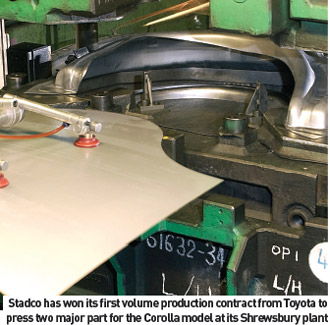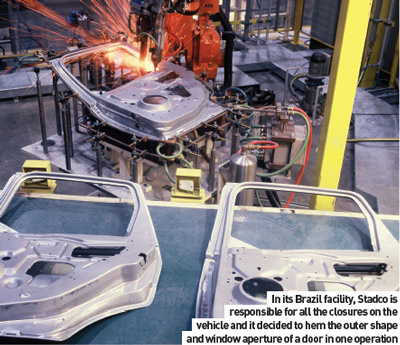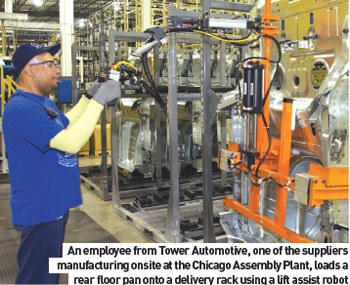.jpg)
Consolidation in the pressing business, both in terms of process steps and suppliers, is seeing the development of smarter applications in body-in-white and door assembly. AMS looks at Stadco and its subassembly supply.
There are several trends that most Tier One bodywork manufacturers would recognise that are driving the industry at present: the growing complexity of assemblies, a continued consolidation of the supplier base and the usual demands to reduce cost.
“The OEMs continue to look to us in the body-in-white arena to do more in terms of modular sub-assemblies,” Craig Corrington, Vice President, North American Operations, Tower Automotive, says. “A lot of the original work that they did a few years ago in the body shops, they are now trying to get to the position where that comes into the shop already undertaken by suppliers as part of a sub-assembly.”
He explains that this move is prompted by OEM’s need to reconfigure their body shops to accommodate multiple vehicles. As a result, some of the assembly work they would have traditionally carried out inhouse is now done externally. “We are working with them [on a] strategy to accommodate these sub-assemblies,” he adds. “They can just take a sub-assembly and put it into their system, which provides them with the opportunity not to have to tool up. This gives them more white space to utilise for different body shop configurations.
“As we get into sub-assembly work the real problem becomes involves the bigger components. You have to rationalise your shipping strategy because you are no longer able to ship 100 parts in a container straight into a body shop. Now you are shipping sub-assemblies in a rack that can hold ten, so the transportation costs become an issue that has to become rationalised.”
This trend is something Paul Meeson, Advanced Engineering Director at Stadco, feels has grown since the arrival of the Japanese manufacturers in Europe. “When Honda linked up with Rover in the UK, many, many years ago, they brought with them a slightly different approach to body structure manufacturing,” he says. “Up until that point all the OEMs in Europe worked on the basis that they would do everything themselves; they were vertically integrated. What Honda brought to the UK was ‘we don’t do it all ourselves, we have a core manufacturing process that we excel at and we have partner companies which focus on the bits that they are good at’. So if you go to any Honda facility, they don’t make all the body themselves, they work at a higher sub-assembly level and maintain their core processes and purchase in major sub-assemblies from companies like us.”
Another trend that Meeson is witnessing will be familiar to all automotive suppliers, namely the consolidation of the supply chain. “One OEM may have more than 20 companies that it looks to for outsourced metal parts of the body and they will be looking to consolidate that to two,” he says. “This means that the larger companies will tend to survive and the smaller companies will either disappear or become sub-suppliers to the larger companies.
“What is also happening in parallel is that, in taking that route, the OEM may have chosen to split the work up over a number of suppliers and they have to manage all those suppliers on a new model programme. The approach that they are now tending to take is to deal with one company for all the outsourced metal on the programme; that is the type of relationship that we enjoy with BMW on the MINI.
The only company outside of BMW that supplies body components for the MINI programme is Stadco.”
Typical of the entire supply chain, downward cost pressure allied with increased performance and functionality are the bywords of the bodywork sub-assemblers. “The customers themselves are continually looking to improve on such things as the crash worthiness and torsional rigidity of the body shell, which can introduce more material into the product as well as increased welding,” Meeson says.
“The way we try to offset that is by utilising smarter ways to undertake the manufacturing process. A lot of the vehicle body structure is spot-welded and we are doing an awful lot of work in looking at the feasibility of laser welding to manufacture body sub-assemblies because of the potential benefits of massively improving process speeds.”
Innovation in both process and product is essential for any automotive supplier. Within bodywork sub-assembly, a great deal of it still comes from the OEMs themselves, although there is an increasing co-operation between the engineering plants of OEMs and their Tier Ones.
Much like other bodywork suppliers, Tower has some input into the design and engineering phase but concede much of it is OEM driven. “The technologies used would predominantly be a requirement from the OEM and they would be the ones to determine what they require based on the engineering of the vehicle – what kind of structural components that they would want us to use in terms of the type of material,” Corrington adds. “Certainly, we would be part of the discussion in terms of what options might be out there. But it is pretty safe to say that the trend in terms of high-strength steel, things of that nature, are going to continue, especially with the work that the OEMs are doing in trying to reduce the weight of the vehicle. So knowing their long-term strategy for the material in the body-inwhite gives us the ability to start looking at our operation and how we need to align ourselves to accommodate that.”
Many companies have worked closely with OEMs to set up plant close to, or even within, the assembly plants. Stadco’s position at the Ford Saarlouis plant is an example, as is Tower Automotive’s at Ford’s Chicago assembly plant.
 The Stadco plant in Saarlouis is linked directly with the Ford plant there that makes the Focus. “We construct a very high proportion of the body shell for Ford in the form of sub-assemblies,” Meeson says. “Ford has mirrored the approach that Honda has taken to some extent.
The Stadco plant in Saarlouis is linked directly with the Ford plant there that makes the Focus. “We construct a very high proportion of the body shell for Ford in the form of sub-assemblies,” Meeson says. “Ford has mirrored the approach that Honda has taken to some extent.
They have the main production facilities inside their body shop and we feed that production facility with high-level sub-assemblies; we produce the complete body side inner for the Ford Focus.
“Another example of this would be the work that we undertook with Ford in Brazil. We were responsible for setting up a stamping facility and half a body shop with them for a new car plant based in Salvador in the Northern part of Brazil – a Greenfield facility to build 250,000 vehicles a year.”
One of Tower Automotive’s facilities in the US is in Chicago, on Ford’s Supplier Campus adjacent to its huge Chicago Assembly facility. When it comes to talking about the workings of its Chicago plant there is no man better to talk to than Matt Pollick, Director of Programme Management, who used to be Plant Manager at Chicago.
 The major assemblies that are made for Ford at the facility are the rear floor pan assembly, the inner fender assembly, the front rail assembly and the engine cradle.
The major assemblies that are made for Ford at the facility are the rear floor pan assembly, the inner fender assembly, the front rail assembly and the engine cradle.
The majority of these are manufactured from high-strength steel, or dual phase material. The usual pattern is to build one model per shift, small batches of from 600-1,000 before they change over, with trucks making the short trip to the plant every 15 minutes.
“We have three transfer press lines there, two 2,000 ton transfer presses and a 3,000 ton transfer press,” Pollick says. “We have 300 Fanuc welding robots, most of the welding equipment is mid-frequency DC because of the predominance of high-strength steel and dual phase.
“From the welding standpoint there are a couple of things that high-strength steel does that can cause a problem. With high-strength steels it is harder to bring the materials together to achieve the weld; it takes fairly high clamp pressures. It also takes multiple weld schedules and in our case we use midfrequency DC welding, the technology of which has been around for a while, but some of that technology has become predominant in the US over the past couple of years.
“So there have been a lot of changes in the welding industry with servo guns and midfrequency DC welding, just because of the growing use of high-strength steels.
We have got some different parameters now for welding. “In terms of complexity, the rear floor assembly that we make is probably the most complex that I have ever seen outsourced by Ford. That assembly has 347 welds on just the Ford Freestyle floor pan, so that is almost a third of the car’s weld on just one assembly that we ship in.”
In its Brazil facility, Stadco is responsible for all the closures on the vehicle and it decided to hem the outer shape and window aperture of a door in one operation, having previously done it in two operations. Less process steps leads to a quality improvement, as well as less floorspace and less capital investment.
 “From a product point of view we make a lot of products for Aston Martin,” Meeson says. “We make the doors for the latest range. It is a mixed material product with a magnesium casting for the door inner and an aluminium outer panel which we glue and hem together.
“From a product point of view we make a lot of products for Aston Martin,” Meeson says. “We make the doors for the latest range. It is a mixed material product with a magnesium casting for the door inner and an aluminium outer panel which we glue and hem together.
“The door in Brazil was for a high volume, low cost vehicle, the Fiesta, where manufacturing technology was the interesting point, whereas the Aston Martin product was all about interesting materials going into the product.” Jaguar, Land Rover and Toyota are three significant business gains for Stadco. The company recently announced that it has won its first volume production contract from Toyota to press two major parts for the Corolla model at its Shrewsbury plant in the UK, which will then be supplied directly to Toyota’s Burnaston plant in Derbyshire.
Production at Stadco Shrewsbury of the two parts, the left and right panel quarter wheelhouse, started in early February. Parts are transported to Burnaston four times daily, five days a week.
Stadco also now supplies a number of major aluminium skin panels for the Range Rover Sport direct to Land Rover’s Solihull plant from its new pressing facility at Castle Bromwich. Dave Jarrett, Stadco’s Technical Engineering Director, says: “Compared to steel, aluminium pressings are more technically challenging and pose particular manufacturing issues. Thanks to our work on vehicles such as the Discovery 3 and the all-aluminium Jaguar XJ saloon, we have gained valuable experience.”
Body panels for the Range Rover Sport will be pressed in a Schuler press line, which is also used to press parts for the Discovery 3. Importantly, the Schuler press line has the specialist features required to produce the large complex outer and inner panels needed to meet Land Rover’s specific design requirements for both models.
“The Schuler press line is also fully enclosed and is fronted by a blank washing machine and reoiler, which removes the transit lubricant applied to the blanks (to which aluminium is very sensitive), and reapplies lubricants on the line where necessary for the pressing process,” Jarrett continues.
Constructed on the former Dunlop site, the plant has enjoyed considerable investment since it opened in March 2004. Importantly, the investment has allowed Stadco to engineer the facility so that it is fully compatible with the PAG’s largest press shops – known as PG1 facilities – as well as other vehicle manufacturers.
For its Jaguar work Stadco has commissioned a new bumper assembly cell at its just-in-time facility located adjacent to Jaguar’s Halewood plant. The new cell will allow Jaguar the manufacturing flexibility to use alternative materials on recently launched and freshened model variants, for example, the switch to an all aluminium extruded bumper for the X400. In addition the cell has been designed to allow Stadco the capability to accommodate any future design variants required by its customers.
 Working in partnership with Jaguar and material supplier Alcan, Stadco first undertook feasibility studies for the new bumper assembly cell back in 2002. While Alcan supplied the aluminium bumper beam, Stadco developed and manufactured the steel crush can-welded assembly.
Working in partnership with Jaguar and material supplier Alcan, Stadco first undertook feasibility studies for the new bumper assembly cell back in 2002. While Alcan supplied the aluminium bumper beam, Stadco developed and manufactured the steel crush can-welded assembly.
As aluminium cannot be welded to steel the switch to an aluminium bumper (for the X-Type for example) posed an early challenge for Stadco. The new assembly cell had to be capable of bolting together the required components whilst maintaining efficient cycle and production times.
To meet Jaguar’s specific requirements, Stadco appointed the UK arm of Comau to help design, manufacture and install the assembly line. Comau is a company with particular expertise in automated welding and joining services and are a major equipment supplier directly to Jaguar.
“Comau played an important part in the successful completion of the project,” says Graeme Cowey, Stadco Group Programme Manager. “By combining Comau’s expertise with our experience in pressing and sub-assembly processes, we have been able to deliver a highly automated, flexible cell, with four state-of-the-art robots that are capable of a productive cycle time of thirty five parts an hour.”
As well as overcoming the challenges of working with a new material, Stadco also had the task of working closely with Alcan to ensure the successful completion of the project. Commenting on the timescales set by Jaguar, Cowey concludes: “There is growing pressure today on all vehicle manufacturers around the world to bring new products to market faster. Our flexible joint project management approach enabled us to successfully complete each major milestone for this project in partnership with Alcan on time and to Jaguar’s specification.”



































